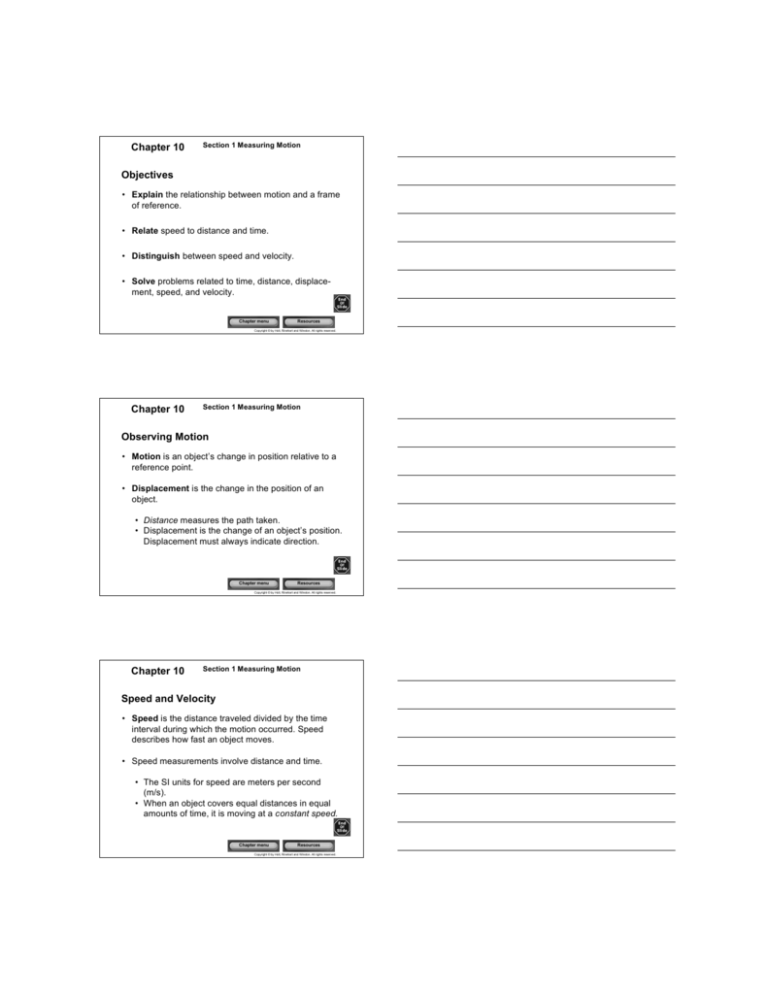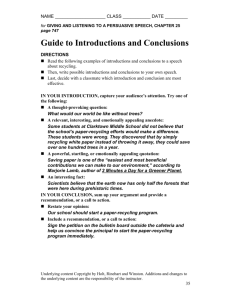
Chapter 10
Section 1 Measuring Motion
Objectives
• Explain the relationship between motion and a frame
of reference.
• Relate speed to distance and time.
• Distinguish between speed and velocity.
• Solve problems related to time, distance, displacement, speed, and velocity.
Chapter menu
Resources
Copyright © by Holt, Rinehart and Winston. All rights reserved.
Chapter 10
Section 1 Measuring Motion
Observing Motion
• Motion is an object’s change in position relative to a
reference point.
• Displacement is the change in the position of an
object.
• Distance measures the path taken.
• Displacement is the change of an object’s position.
Displacement must always indicate direction.
Chapter menu
Resources
Copyright © by Holt, Rinehart and Winston. All rights reserved.
Chapter 10
Section 1 Measuring Motion
Speed and Velocity
• Speed is the distance traveled divided by the time
interval during which the motion occurred. Speed
describes how fast an object moves.
• Speed measurements involve distance and time.
• The SI units for speed are meters per second
(m/s).
• When an object covers equal distances in equal
amounts of time, it is moving at a constant speed.
Chapter menu
Resources
Copyright © by Holt, Rinehart and Winston. All rights reserved.
Chapter 10
Section 1 Measuring Motion
Speed and Velocity, continued
• Speed can be studied with
graphs and equations.
• Speed can be determined
from a distance-time graph.
When an object’s motion is
graphed by plotting
distance on the y-axis and
time on the x-axis, the
slope of the graph is
speed.
Chapter menu
Resources
Copyright © by Holt, Rinehart and Winston. All rights reserved.
Chapter 10
Section 1 Measuring Motion
Speed and Velocity, continued
• Average speed is calculated as distance divided by
time.
Equation for Average Speed
• Instantaneous speed is the speed at a given point in
time.
Chapter menu
Resources
Copyright © by Holt, Rinehart and Winston. All rights reserved.
Chapter 10
Section 1 Measuring Motion
Math Skills
Velocity Metal stakes are sometimes placed in glaciers
to help measure a glacier’s movement. For several
days in 1936, Alaska’s Black Rapids glacier surged
as swiftly as 89 meters per day down the valley.
Find the glacier’s velocity in m/s. Remember to
include direction.
1. List the given and the unknown values.
Given:
time, t = 1 day
displacement, d = 89 m down the valley
Unknown: velocity, v = ? (m/s and direction)
Chapter menu
Resources
Copyright © by Holt, Rinehart and Winston. All rights reserved.
Chapter 10
Section 1 Measuring Motion
Math Skills, continued
2. Perform any necessary conversions.
To find the velocity in meters per second, the
value for time must be in seconds.
Chapter menu
Resources
Copyright © by Holt, Rinehart and Winston. All rights reserved.
Chapter 10
Section 1 Measuring Motion
Math Skills, continued
3. Write the equation for speed.
4. Insert the known values into the equation, and
solve.
Chapter menu
Resources
Copyright © by Holt, Rinehart and Winston. All rights reserved.
Chapter 10
Section 1 Measuring Motion
Speed and Velocity, continued
• Velocity is the speed of an object in a particular
direction.
• Velocity describes both the speed and the direction.
• Combine velocities to determine the resultant
velocity.
Chapter menu
Resources
Copyright © by Holt, Rinehart and Winston. All rights reserved.
Chapter 10
Section 2 Acceleration
Objectives
• Describe the concept of acceleration as a change in
velocity.
• Explain why circular motion is continuous
acceleration even when the speed does not change.
• Calculate acceleration as the rate at which velocity
changes.
• Graph acceleration on a velocity-time graph.
Chapter menu
Resources
Copyright © by Holt, Rinehart and Winston. All rights reserved.
Chapter 10
Section 2 Acceleration
Acceleration and Motion
• Acceleration is the rate at which velocity changes
over time.
• An object accelerates if its speed, direction, or both
change.
Chapter menu
Resources
Copyright © by Holt, Rinehart and Winston. All rights reserved.
Chapter 10
Section 2 Acceleration
Acceleration and Motion, continued
• Acceleration can be a change in speed.
• Acceleration can be a change in direction.
• Uniform circular motion is constant acceleration.
Chapter menu
Resources
Copyright © by Holt, Rinehart and Winston. All rights reserved.
Chapter 10
Section 2 Acceleration
Calculating Acceleration
• Acceleration is the rate at which velocity changes.
Acceleration Equation (for straight-line motion)
• In SI units, acceleration is measured in meters per
second per second (m/s/s) or m/s2.
Chapter menu
Resources
Copyright © by Holt, Rinehart and Winston. All rights reserved.
Chapter 10
Section 2 Acceleration
Math Skills
Acceleration A flowerpot falls off a second-story
windowsill. The flowerpot starts from rest and hits
the sidewalk 1.5 s later with a velocity of 14.7 m/s.
Find the average acceleration of the flowerpot.
1. List the given and the unknown values.
Given:
time, t = 1.5 s
initial velocity, vi = 0 m/s
final velocity, vf = 14.7 m/s down
Unknown: acceleration, a = ? (m/s2 and direction)
Chapter menu
Resources
Copyright © by Holt, Rinehart and Winston. All rights reserved.
Chapter 10
Section 2 Acceleration
Math Skills, continued
2. Write the equation for acceleration.
3. Insert the known values into the equation, and
solve.
Chapter menu
Resources
Copyright © by Holt, Rinehart and Winston. All rights reserved.
Chapter 10
Section 2 Acceleration
Calculating Acceleration, continued
Acceleration can be
determined from a
velocity-time graph.
Chapter menu
Resources
Copyright © by Holt, Rinehart and Winston. All rights reserved.
Chapter 10
Section 3 Motion and Force
Objectives
• Explain the effects of unbalanced forces on the
motion of objects.
• Compare and contrast static and kinetic friction.
• Describe how friction may be either harmful or
helpful.
• Identify ways in which friction can be reduced or
increased.
Chapter menu
Resources
Copyright © by Holt, Rinehart and Winston. All rights reserved.
Chapter 10
Section 3 Motion and Force
Balanced and Unbalanced Forces
• Force is an action exerted on a body in order to
change the body’s state of rest or motion. Force has
magnitude and direction.
• The net force is the combination of all forces
acting on an object.
• Objects subjected to balanced forces either do not
move or move at constant velocity.
• An unbalanced force must be present to cause any
change in an object’s state of motion or rest.
Chapter menu
Resources
Copyright © by Holt, Rinehart and Winston. All rights reserved.
Chapter 10
Section 3 Motion and Force
The Force of Friction
• Friction is a force that opposes motion between two
surfaces that are in contact.
• Friction opposes the applied force.
Chapter menu
Resources
Copyright © by Holt, Rinehart and Winston. All rights reserved.
Chapter 10
Section 3 Motion and Force
The Force of Friction, continued
• Static friction resists the initiation of sliding motion
between two surfaces that are in contact and at rest.
• Kinetic friction opposes the movement of two
surfaces that are in contact and are sliding over each
other.
• Static friction is greater than kinetic friction.
• There are many different types of kinetic friction, such
as sliding friction and rolling friction.
• Fluid friction, such as air resistance, also opposes
motion.
Chapter menu
Resources
Copyright © by Holt, Rinehart and Winston. All rights reserved.
Chapter 10
Section 3 Motion and Force
Frictional Forces and Acceleration
Chapter menu
Resources
Copyright © by Holt, Rinehart and Winston. All rights reserved.
Chapter 10
Section 3 Motion and Force
Friction and Motion
• Friction can be helpful or harmful.
• Friction is necessary to roll a vehicle or hold an
object.
• However, friction can also cause excessive
heating or wear of moving parts.
• Harmful friction can be reduced.
• Helpful friction can be increased.
Chapter menu
Resources
Copyright © by Holt, Rinehart and Winston. All rights reserved.







